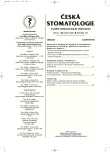State of Dentition in Non-Cooperative Children Treated at the Stomatological Clinic in Brno in 2004
Stav chrupu u nespolupracujících dětí ošetřených na Stomatologické klinice v Brně v roce 2004
Práce byla zaměřena na rozbor situace u skupiny dětí, která se v roce 2004 dostavila na dětské oddělení Stomatologické kliniky LF MU a FN v Brně s diagnózou nespolupracující pacient. Cílem práce bylo stanovit stav chrupu u dětí ve věku 6–19 let (N = 78), které byly na Stomatologické klinice vyšetřeny a následně ošetřeny v celkové anestezii (CA), a dále porovnat počet výkonů zjištěných při prvotním vyšetření a skutečných výkonů provedených při ošetření v CA. Zaměřili jsme se též na údaje, jaký byl důvod nespolupráce dítěte, odkud byl pacient s doporučením odeslán a ke které zdravotní pojišťovně přísluší. Práce je založena na datech získaných ze zdravotnické dokumentace. Ke zjištění stavu chrupu byl použit index KPE a RI, děti byly rozděleny do 4 skupin na základě diagnóz: mentální retardace, fobie, kombinace více diagnóz a jiné. Průměrný věk celého souboru byl 11,5 let (SD 3.27). Hodnota KPE činila 4,43, z toho K = 3,85, P = 0,45 a E = 0,13. Statistické hodnocení výsledků provedené Fisher-exact testem prokázalo významně vyšší hodnoty u dívek v KPE (p = 0.0008) a jeho složce P (p = 0.004). Rozdíly ve složce E mezi pohlavími byly marginálně významné (p = 0.04). Restorativní index dosahoval velmi nízké hodnoty, a to 7,77 %. Reálná potřeba ošetření souboru byla nižší než se zdálo při prvním vyšetření. Průměrný interval mezi vyšetřením a ošetřením v CA byl 50,25 dne, průměrná délka ošetření v CA činila 73,61 minuty. Většinu odesílajících zařízení tvořily privátní stomatologické praxe, pacienti byli nejčastěji pojištěnci Všeobecné zdravotní pojišťovny. Práce ukázala, že stav orálního zdraví u hedikepovaných dětí a nespolupracujících dětí je neuspokojivý. Pro zlepšení stavu chrupu nespolupracujících dětí je nutné motivovat rodiče a opatrovnické osoby ke zvýšené péči o orální zdraví těchto dětí a poskytnout jim nutné instrukce a praktický výcvik v technikách péče o chrup.
Klíčová slova:
nespolupracující pacient – KPE – mentální retardace – fobie – celková anestezie
Authors:
L. Pantuček; M. Kukletová; Z. Halačková; L. Izakovičová-Hollá 1; J. Kuklová; M. Svobodová
Authors‘ workplace:
Stomatologická klinika LF MU a FN U Sv. Anny, Brno
přednosta prof. MUDr. J. Vaněk, CSc.
; Ústav patologické fyziologie LF MU, Brno
přednosta prof. MUDr. A. Vašků, CSc.
1
Published in:
Česká stomatologie / Praktické zubní lékařství, ročník 107, 2007, 1, s. 3-9
Category:
Overview
The study has analysed situation in non-cooperative children admitted for dental treatment in 2004. The aim of the study was to evaluate the prevalence of dental caries in 6–19-year-old children (N = 78) treated under general anaesthesia (GA), and to compare the treatment plan based on a child patient’s preliminary examination and the treatment need assessed during the respective therapy. The type of health insurance, reason for poor cooperation and referring facility were followed as well. Dental records of 78 children (mean age 11.5, SD 3.27) were used, the data were gathered and evaluated. The children were divided into 4 groups based on the diagnosis: mental retardation (N = 11), phobia (N = 40), combination of severe diagnoses n = 14), other diagnoses (N = 13). Components and restorative index were calculated. Differences between boys and girls were tested by Fisher-exact test. DMFT of the group was 4.4, DT: 3.85, FT: 0.45, ET: 0.13, RI: 7.77%. DMFT was significantly higher in girls (p = 0.0008) and in the component FT (p = 0.004). The treatment need determined during the therapy under GA was lower than that assessed during the examination. The mean interval between the investigation and treatment under GA was 50.25 days, the mean duration of the treatment under GA was 73.61 minutes. The most frequent referring facility was the private dental practice, most patients belonged to the General Health Insurance. The study has demonstrated poor oral health status in non-cooperative children. Parents and persons taking care of handicapped and non-cooperative children should be trained in caries prophylactic methods to prevent dental decay and its complications.
Key words:
non-cooperative patient – DMFT – mental retardation – phobia – general anaesthesia
Labels
Maxillofacial surgery Orthodontics Dental medicineArticle was published in
Czech Dental Journal

2007 Issue 1
- What Effect Can Be Expected from Limosilactobacillus reuteri in Mucositis and Peri-Implantitis?
- The Importance of Limosilactobacillus reuteri in Administration to Diabetics with Gingivitis
Most read in this issue
- Internal Granuloma – Present State of the Problem
- What is the Silicon Matrix?
- Direct Applications of Fiber. Composites Substitution of Missing Frontal Teeth
- The Causes of Origin and Present Possibility for Treatment of Alveolitis (A Review)
